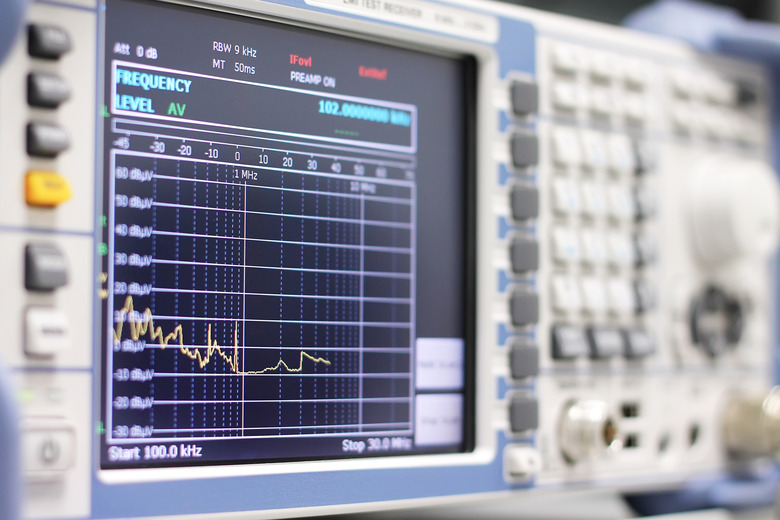How To Find Wattage With Voltage & Frequency
The relationship between wattage, voltage and frequency is governed by circuit impedance. The impedance is a complex form of resistance. It's a combination of regular resistance and the reactive components. Reactive components frequency are dependent components such as inductors and capacitors. Together the resistance and reactive components form the impedance. Once you know the impedance, you can calculate watts.
Step 1
Determine the voltage, V, and the frequency, f. Refer to electrical schematics and operational requirements of the circuits. As an example, assume V is 120 volts and f is 8 megahertz or 8 x 10^6 hertz.
Step 2
Calculate the total resistance of the circuit, or Rt. Rt depends on the number of resistors and how they are connected. If one resistor exist, Rt is the value of that resistor. If several resistors exist, determine if they are connected in series or parallel and use the following formula:
Resistors in Series: Rt = R1 + R2 + R3 ... Rn
Resistors in Parallel: Rt =1/(1/R1 + 1/R2 + 1/R3 ...1/Rn)
As an example, assume Rt is 300 ohms.
Step 3
Calculate the total inductance of the circuit, or Lt. Lt depends on the number of inductors and how they are connected. If only one inductor exist, Lt is the value of that inductor. If several inductors exist, determine if they are connected in series or parallel and use the following formula:
Inductors in series: Lt = L1 + L2 + L3 ... Ln
Inductors parallel: Lt =1/(1/L1 + 1/L2 + 1/L3 ....1/Ln)
As an example, assume Lt is 5 microhenries.
Step 4
Calculate the total capacitance of the circuit, or Ct. Ct depends on the number of capacitors and how they are connected. If only one capacitor exist, Ct is the value of that capacitor. If several capacitor exist, determine if they are connected in series or parallel and use the following formula:
Capacitors in series: Ct =1/(1/C1 + 1/C2 + 1/C3 ...1/Cn)
Capacitors parallel: Ct = C1 + C2 + C3 ... Cn
As an example, assume Ct is 3 microfarads
Step 5
Calculate the reactance from the inductor, or XL, using the formula XL = 2 * pi * f * Lt where pi is 3.1415. Using the example numbers:
XL = 2 * 3.1415 * 8 x 10^6 * 5 x 10^-6 = 251.32 ohms
Step 6
Calculate the reactance associated with the capacitor, or XC, using the formula XC = 1/[2 * pi * f * Ct]. Using the example numbers:
XC = 1/(2 * 3.1415 * 8 x 10^6 * 3 x 10^-6) = 1/150.79 = 0.0066 ohms
Step 7
Calculate total reactance, or XT, using the formula XT = XL – XC. Continuing with the example:
XT = 251.32 – 0.0066 = 251.31
Step 8
Calculate impedance, Z, using the formula Z = sqrt [Rt^2 + XT^2]. Continuing with the example:
Z = sqrt [300^2 + 251.31^2] = sqrt [90,000 + 63,156.7] = sqrt[153,156] = 391.35 ohms.
Step 9
Calculate the circuit current flow, or "I," using the formula I = V/Z. Continuing with the example:
I = 120/391.35 = 0.3 amps
Step 10
Finally, calculate the power, in watts, using the formula P (watts) = V x I. Continuing: P (watts) = 120 x 0.30 = 36 watts.
Cite This Article
MLA
Chestnut, Dwight. "How To Find Wattage With Voltage & Frequency" sciencing.com, https://www.sciencing.com/how-to-find-wattage-with-voltage-frequency-13372439/. 29 December 2018.
APA
Chestnut, Dwight. (2018, December 29). How To Find Wattage With Voltage & Frequency. sciencing.com. Retrieved from https://www.sciencing.com/how-to-find-wattage-with-voltage-frequency-13372439/
Chicago
Chestnut, Dwight. How To Find Wattage With Voltage & Frequency last modified March 24, 2022. https://www.sciencing.com/how-to-find-wattage-with-voltage-frequency-13372439/
